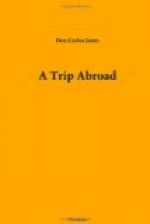The following Tuesday was occupied with a trip on “donkey-back” to Nebi Samwil, Emmaus, Abu Ghosh, and Ain Kairim. Our party was small this time, being composed of Mr. Jennings, Mr. Smith, the writer, and a “donkey-boy” to care for the three animals we rode, when we dismounted to make observations. He was liberal, and sometimes tried to tell us which way to go. We went out on the north side of the city and came to the extensive burial places called the “Tombs of the Judges.” Near by is an ancient wine press cut in the rock near a rock-hewn cistern, which may have been used for storing the wine. En Nebi Samwil is on an elevation a little more than three thousand feet above the sea and about four hundred feet higher than Jerusalem, five miles distant. From the top of the minaret we had a fine view through a field glass, seeing the country for many miles around. This is thought by some to be the Mizpah of the Bible (1 Kings 15:22), and tradition has it that the prophet Samuel was buried here. A little north of Nebi Samwil is the site of ancient Gibeon, where “Abner was beaten, and the men of Israel, before the servants of David” (2 Samuel 2:12-17).
We next rode over to El Kubebeh, supposed by some to be the Emmaus of New Testament times, where Jesus went after his resurrection and sat at meat with his disciples without being recognized. (Luke 24:13-25.) The place has little to attract one. A modern building, which I took to be the residence of some wealthy person, occupies a prominent position, and is surrounded by well-kept grounds, inclosed with a wall. The Franciscan monastery is a good sized institution, having on its grounds the remains of a church of the Crusaders’ period, over which a new and attractive building has been erected. One section of it has the most beautiful floor of polished marble, laid in patterns, that I have ever seen. It also contains a painting of the Savior and the two disciples.
We went outside of the monastery to eat our noon-day lunch, but before we finished, one of the monks came and called us in to a meal at their table. It was a good meal, for which no charge was made, and I understand it is their custom to give free meals to visitors, for they believe that Jesus here sat at meat with his two disciples. We enjoyed their hospitality, but drank none of the wine that was placed before us.
Our next point was Abu Ghosh, named for an old village sheik who, “with his six brothers and eighty-five descendants, was the terror of the whole country” about a century ago. Our object in visiting the spot was to see the old Crusaders’ church, the best preserved one in Palestine. The stone walls are perhaps seven or eight feet thick. The roof is still preserved, and traces of the painting that originally adorned the walls are yet to be seen. A new addition has been erected at one end, and the old church may soon be put in repair.




